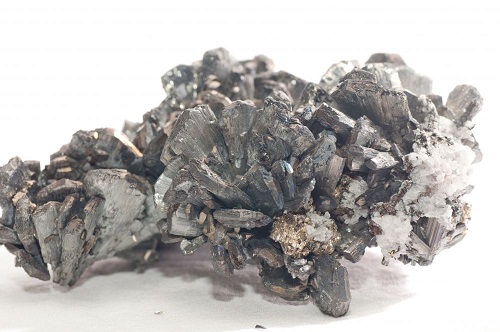Type
Element (Minerals/Ores of)
Mineral Classification
Sulfide
Chemical Formula
Sb2S3
Streak
Similar to color
Mohs Hardness
2


Type
Element (Minerals/Ores of)
Mineral Classification
Sulfide
Chemical Formula
Sb2S3
Streak
Similar to color
Mohs Hardness
2
Crystal System
Orthorhombic
Color
Lead-gray, tarnishing blackish or iridescent; in polished section, white
Luster
Metallic
Fracture
Subconchoidal
A native element, antimony metal is extracted primarily from stibnite, which contains 72 percent antimony and 28 percent sulfur. Stibnite is mined in only a few countries, with China being its largest producer. Antimony is used for many technological and industrial purposes. Antimony is used as a hardening alloy for lead, especially in storage batteries and cable sheaths, and also used in bearing metal, type metal, solder, collapsible tubes and foil, sheet and pipes, and semiconductor technology. Stibnite is used for metal antifriction alloys, metal type, shot, batteries and in the manufacture of fireworks. Antimony salts are used in the rubber and textile industries, in medicine and glassmaking.
Antimony rarely occurs in its native metallic form in nature. It easily combines with other elements, usually including sulfur, to form over 100 different minerals. Of these minerals, only stibnite (Sb2S3) is mined commercially as a source for metallic antimony. Antimony is found in trace amounts in silver, copper and lead ores, and it is usually economically possible, as well as environmentally desirable, to extract the antimony from these ores when they are smelted.
Most of the antimony mined each year comes from China, which supplies over three-quarters of the world’s total. The remainder is from Russia, South Africa, Tajikistan, Bolivia, and a few other countries, including the United States. Some antimony is produced as a by-product of smelting ores of other metals, mainly gold, copper and silver, in countries such as the United States, Canada, and Australia.
Important amounts of antimony are yielded as a by-product of copper and silver mining. Numerous stibnite deposits occur in Idaho, Montana and Nevada. Recycling of old lead-acid batteries contributes to U.S. antimony production.
Antimony is used as a hardening alloy for lead, especially in storage batteries and cable sheaths, and also used in bearing metal, type metal, solder, collapsible tubes and foil, sheet and pipes, and semiconductor technology. Stibnite is used for metal antifriction alloys, metal type, shot, batteries, and in the manufacture of fireworks. Antimony salts are used in the rubber and textile industries, in medicine, and glassmaking.
The most important use of antimony in the United States is in chemicals used to impregnate plastics, textiles, rubber and other materials as a flame retardant – that is, a form of fireproofing. This is required by federal law for certain childrens’ clothing. Over half the annual U.S. antimony consumption is for the manufacture of flame retardants.
A portion of U.S. consumption is in antimony alloys. Antimony is mixed (that is, alloyed) with other metals, such as lead, to make the lead harder and stronger for use in lead-acid batteries. On the other hand, some alloys such as Babbitt Metal (an alloy of antimony, tin, copper and sometimes lead) are useful as machine bearings because they are soft and slippery. Antimony is also alloyed with tin to make pewter items such as plates, pitchers and cups, used mostly for decoration. One use of antimony, which is declining, is to make type metal for printing newspapers and magazines. Antimony is one of very few substances (bismuth and water are two others) which expand when it cools and freezes. Antimony-bearing type metal thus fills every corner of a mold used to prepare sharp type for printing. With the advent of computer printing, this use has greatly decreased.
Antimony is also used for pigments in plastics, paints, rubber, and for a wide variety of minor uses, including medicines, fireworks and others. Antimony oxide is a brilliant yellow color, accounting for much of the pigment use.
A tiny amount of highly purified antimony metal is used in the computer industry to make semiconductors. To be useful in this application, antimony has to be 99.999% pure!
If you have some questions about our products, please feel free to fill out the form below, and we will contact you within 24 hours. Rest assured that we won’t reveal your information to anyone.